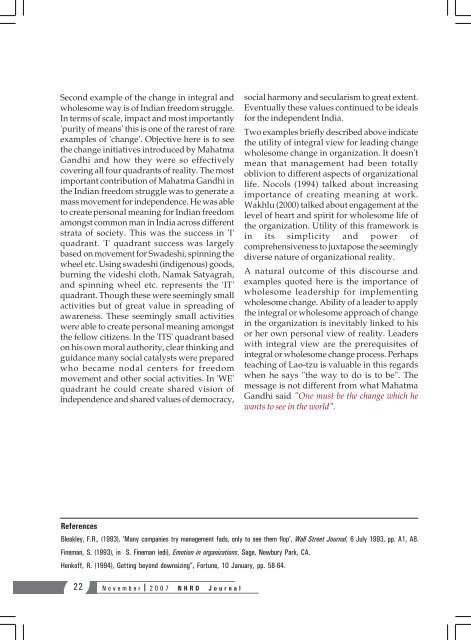NHRD Journal - National HRD Network
NHRD Journal - National HRD Network
NHRD Journal - National HRD Network
Create successful ePaper yourself
Turn your PDF publications into a flip-book with our unique Google optimized e-Paper software.
Second example of the change in integral and<br />
wholesome way is of Indian freedom struggle.<br />
In terms of scale, impact and most importantly<br />
'purity of means' this is one of the rarest of rare<br />
examples of 'change'. Objective here is to see<br />
the change initiatives introduced by Mahatma<br />
Gandhi and how they were so effectively<br />
covering all four quadrants of reality. The most<br />
important contribution of Mahatma Gandhi in<br />
the Indian freedom struggle was to generate a<br />
mass movement for independence. He was able<br />
to create personal meaning for Indian freedom<br />
amongst common man in India across different<br />
strata of society. This was the success in 'I'<br />
quadrant. 'I' quadrant success was largely<br />
based on movement for Swadeshi, spinning the<br />
wheel etc. Using swadeshi (indigenous) goods,<br />
burning the videshi cloth, Namak Satyagrah,<br />
and spinning wheel etc. represents the 'IT'<br />
quadrant. Though these were seemingly small<br />
activities but of great value in spreading of<br />
awareness. These seemingly small activities<br />
were able to create personal meaning amongst<br />
the fellow citizens. In the 'ITS' quadrant based<br />
on his own moral authority, clear thinking and<br />
guidance many social catalysts were prepared<br />
who became nodal centers for freedom<br />
movement and other social activities. In 'WE'<br />
quadrant he could create shared vision of<br />
independence and shared values of democracy,<br />
social harmony and secularism to great extent.<br />
Eventually these values continued to be ideals<br />
for the independent India.<br />
Two examples briefly described above indicate<br />
the utility of integral view for leading change<br />
wholesome change in organization. It doesn't<br />
mean that management had been totally<br />
oblivion to different aspects of organizational<br />
life. Nocols (1994) talked about increasing<br />
importance of creating meaning at work.<br />
Wakhlu (2000) talked about engagement at the<br />
level of heart and spirit for wholesome life of<br />
the organization. Utility of this framework is<br />
in its simplicity and power of<br />
comprehensiveness to juxtapose the seemingly<br />
diverse nature of organizational reality.<br />
A natural outcome of this discourse and<br />
examples quoted here is the importance of<br />
wholesome leadership for implementing<br />
wholesome change. Ability of a leader to apply<br />
the integral or wholesome approach of change<br />
in the organization is inevitably linked to his<br />
or her own personal view of reality. Leaders<br />
with integral view are the prerequisites of<br />
integral or wholesome change process. Perhaps<br />
teaching of Lao-tzu is valuable in this regards<br />
when he says "the way to do is to be". The<br />
message is not different from what Mahatma<br />
Gandhi said "One must be the change which he<br />
wants to see in the world".<br />
References<br />
Bleakley, F.R., (1993), ‘Many companies try management fads, only to see them flop’, Wall Street <strong>Journal</strong>, 6 July 1993, pp. A1, A8.<br />
Fineman, S. (1993), in S. Fineman (edi), Emotion in organizations, Sage, Newbury Park, CA.<br />
Henkoff, R. (1994), Getting beyond downsizing”, Fortune, 10 January, pp. 58-64.<br />
22<br />
November 2007 <strong>N<strong>HRD</strong></strong> <strong>Journal</strong>
















